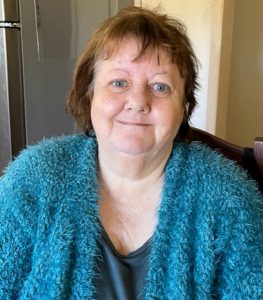Patty Hoodless

Patty’s journey
In 2015, Patty was working as a director of a childcare centre and was passionate about supporting kids in their development. One day at work Patty didn’t feel well and went home. Later that day Patty decided to go to hospital and that was when Patty had a stroke, leaving her with a brain injury at 52.
“When I was in the hospital at Hervey Bay, I don’t know what happened. I thought I must have blacked out or been out of it. I only remember going into the hospital and then it was a day or so later and I knew something had happened. At the time I didn’t know a lot about stroke and I’m still learning,” said Patty.
Disconnected from the body
After her stroke, Patty felt disconnected from the right side of her body. She felt a great deal of anger towards it as it was once the leader and now had to be dragged around and caused her pain.
“For a long time after I couldn’t relate to the right side of my body. I was so dependent on my right side then suddenly it didn’t work, and I found that really hard. Now, it comes out and does certain things because it’s made to do things and be part of one body. When I write with my left hand (because I learnt to write with that hand) my right-side twitches and moves as if it wants to be part of one body and remembers, but it can’t hold a pen.”
Learning and growing
Working in childcare, Patty often compares her recovery to a child learning new things. Over time Patty has had to relearn how to do simple tasks in everyday life like making the bed or taking out the garbage.
“I assessed my ability to feed myself, walk, and talk like I would do in work with a child. It was like a child learning how to do things for the first time. It’s given me a lot of admiration for children because I’ve found it so hard! Kids are working hard all the time.”
Working through challenges
Patty’s family and the childcare centre were eager for her to return to work when she completed her rehab, so Patty did. At that stage, she couldn’t remember how to read or write and couldn’t use a computer. There wasn’t a planned ‘return to work’ program where therapists and employees worked together to optimise Patty’s chances of succeeding or finding a role that she was able to do.
“I tried to explain how the stroke had affected me, but I was still learning myself. Without professional guidance my work didn’t fully understand how the stroke was impacting me. It was difficult because my concentration would go, and I’d lose memory again of what I was doing. I remember when everyone would leave for the day I would stay back and try and teach myself things like how to print.”
Furry friends
The challenges returning to work did see Patty retire early, which left her with quite a void in her life. Patty was then so thankful that she adopted two cats, Henry and Hugo to give her purpose after leaving her job.
“If my cats didn’t come along, I’d have no purpose and there’s so much that they give me. It took away that void because I cared for a lot of people in my work, and I lost that when I had the stroke. As a person, I didn’t cope well with losing that and so my care went to the cats.”
Patty is eager to let others who’ve experienced a stroke know that having access to the right information about stroke and taking it at your own pace can make all the difference when recovering from stroke.
“Go at your own pace. Work out what works for you as an individual. You find all these little things that assist you in how you cope with your daily life.”